Dynamic Programming Algorithms Definition A quite generic strategy


























































































































































































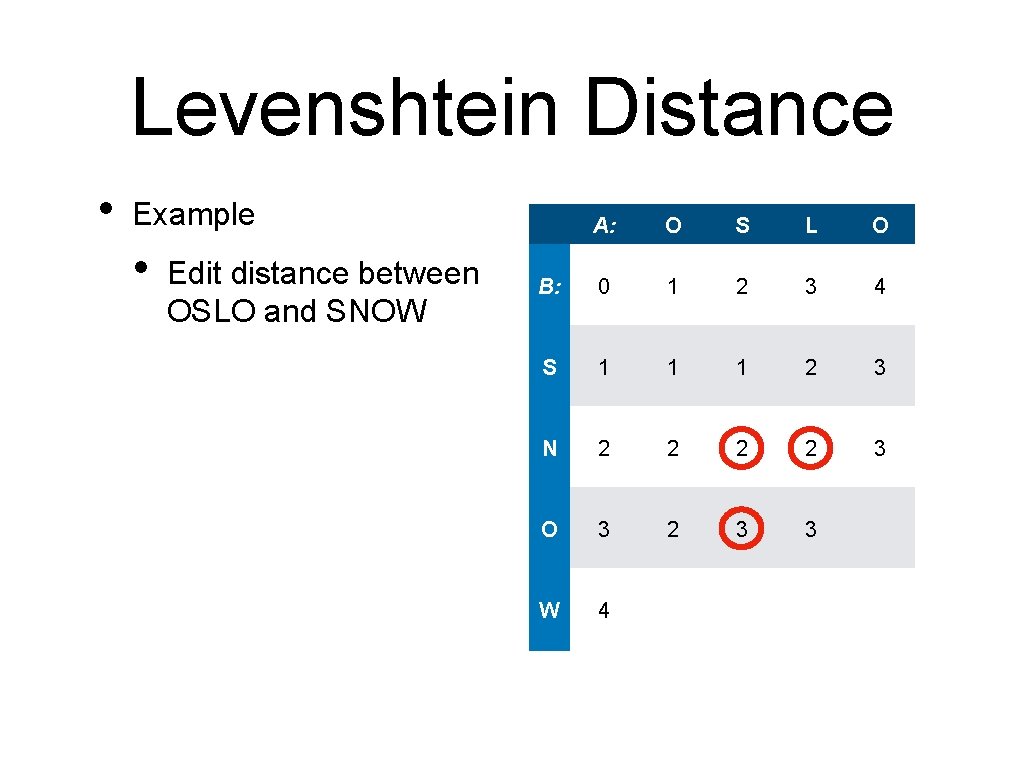
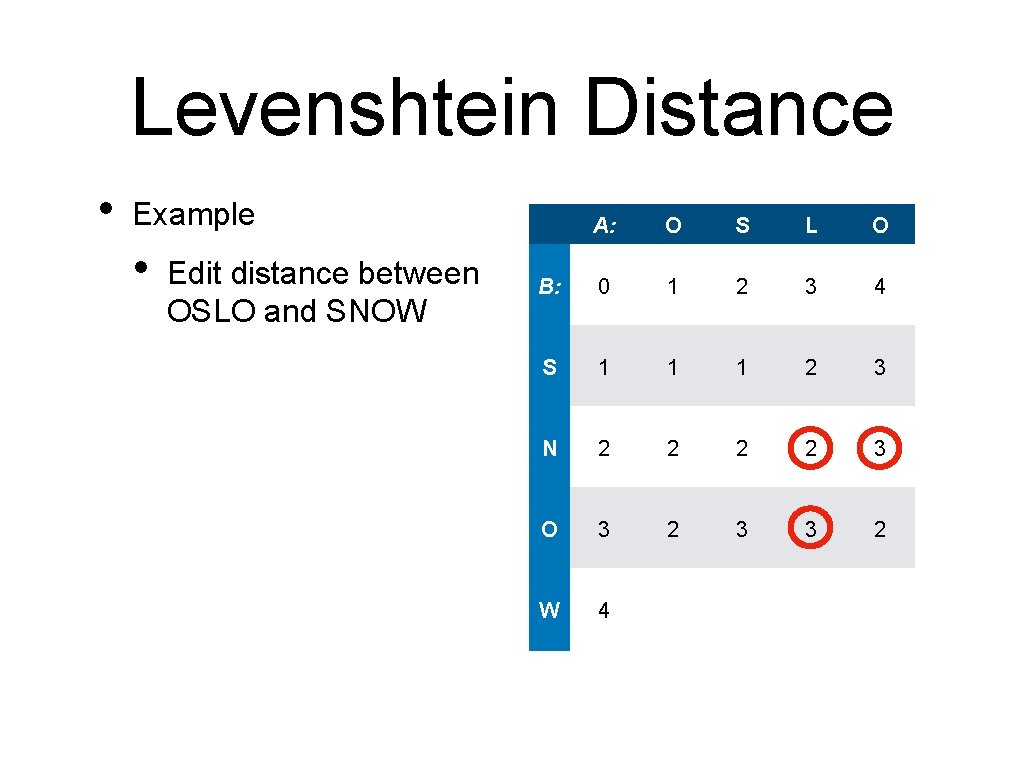
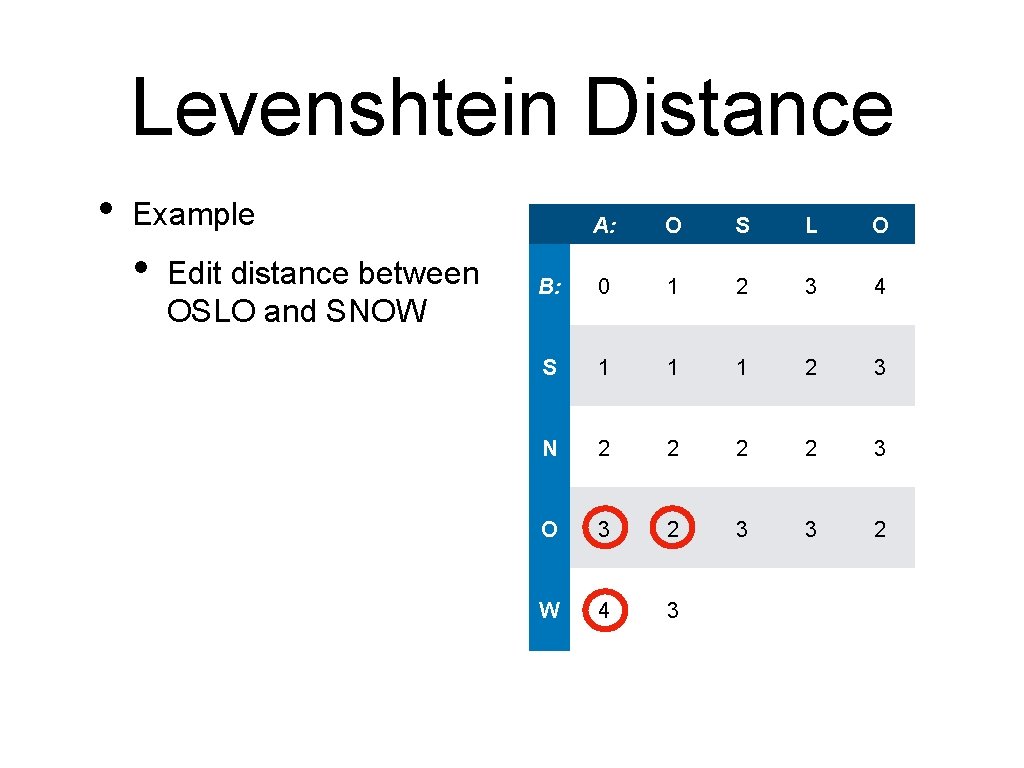
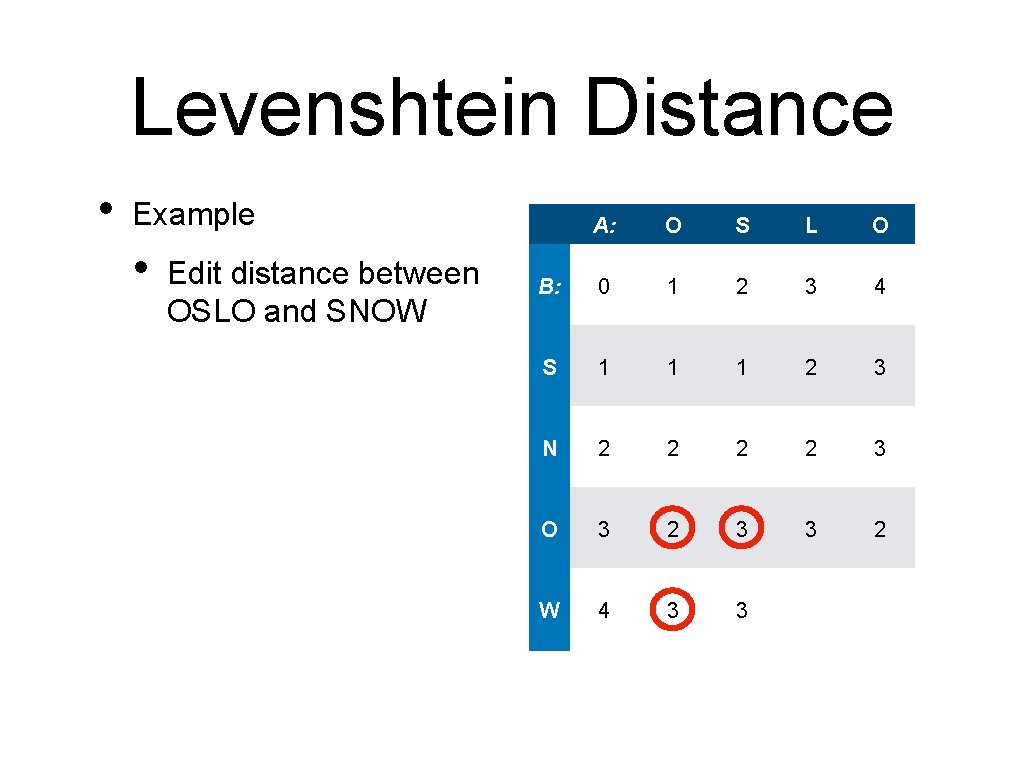
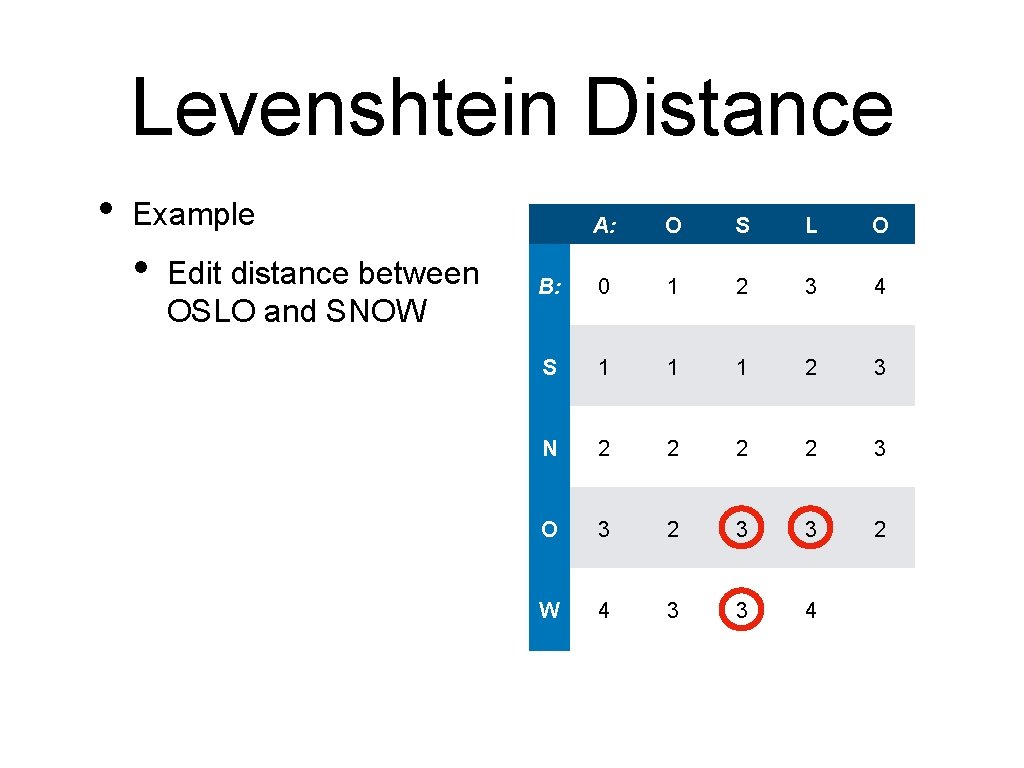
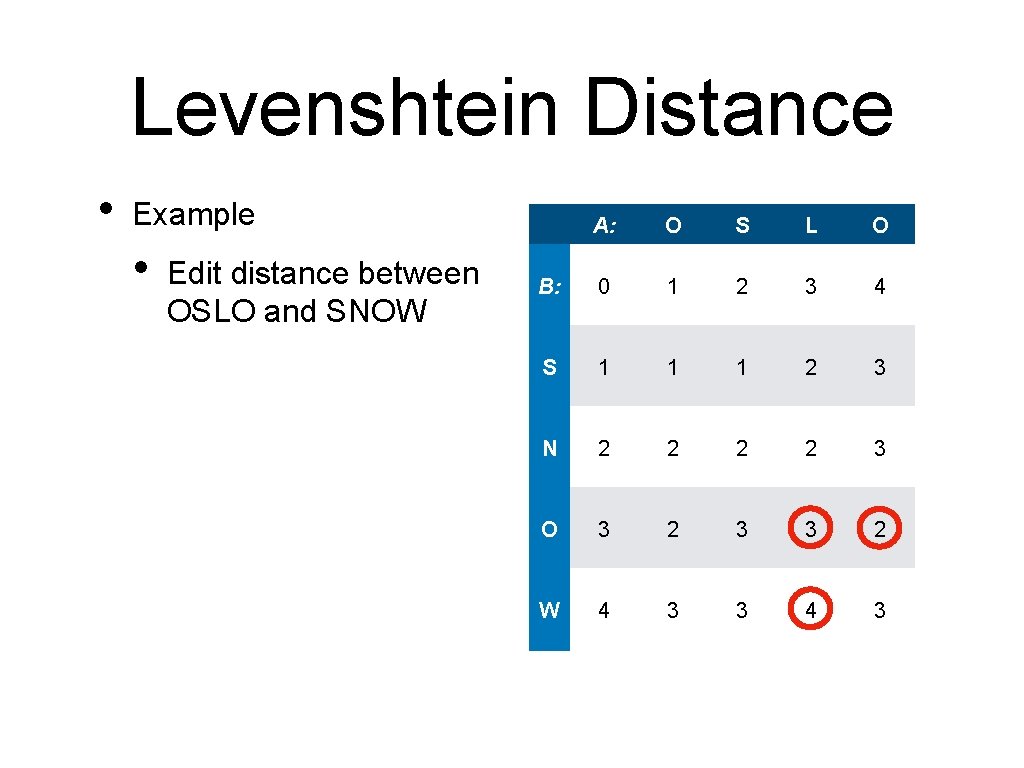
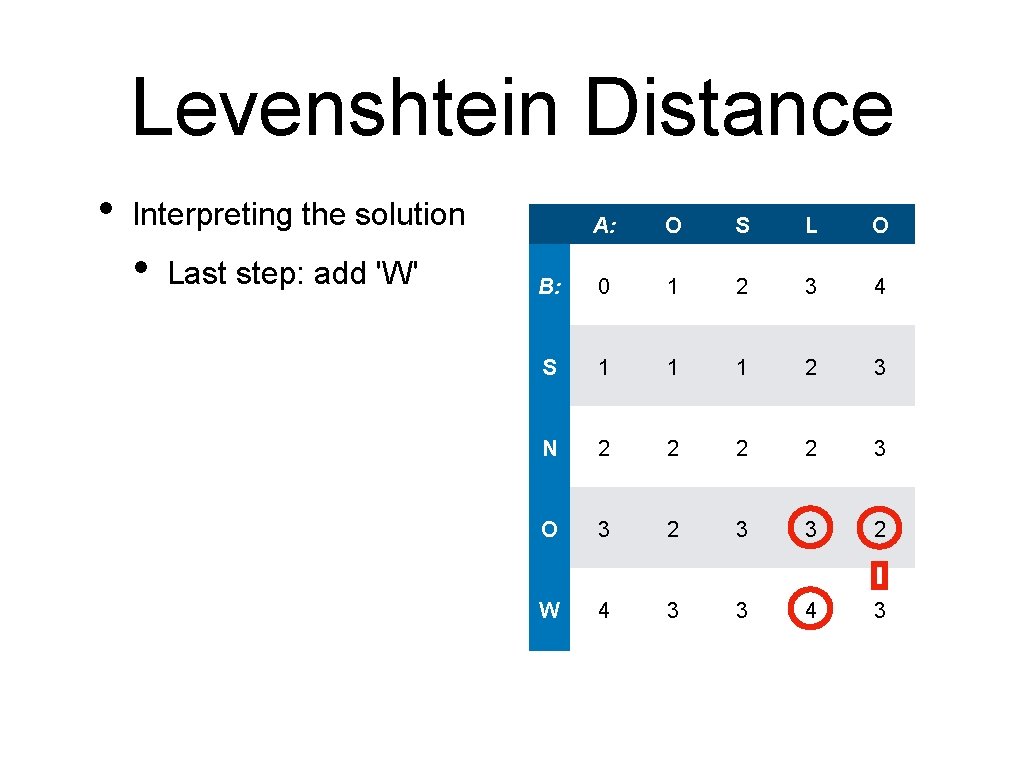
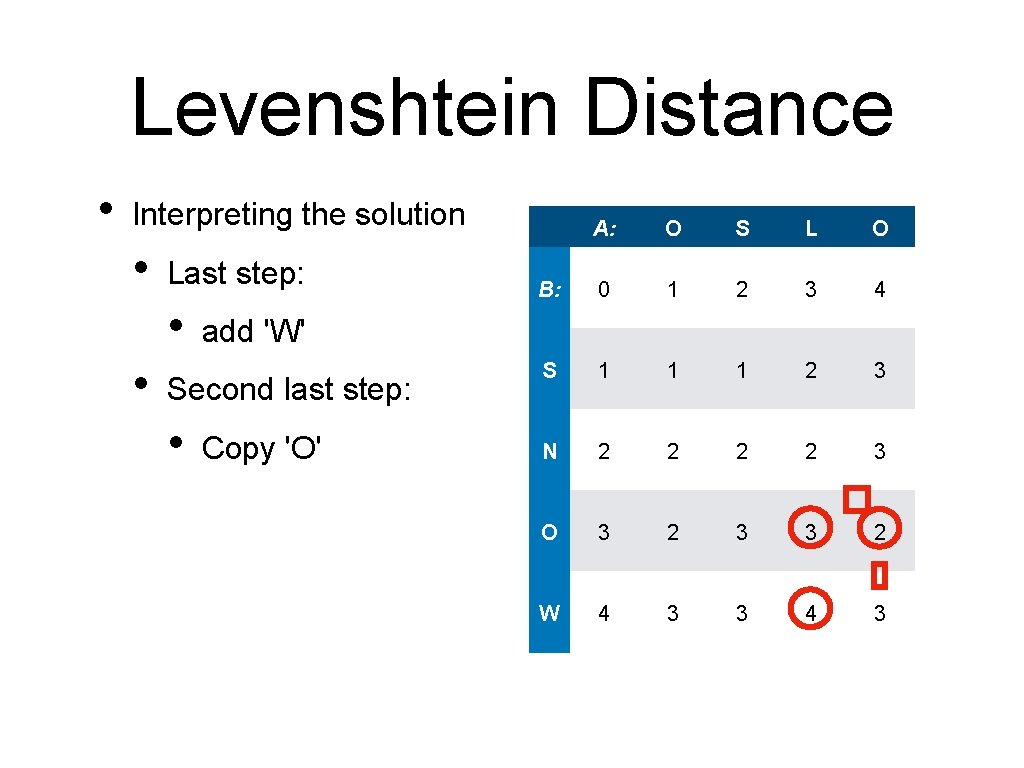
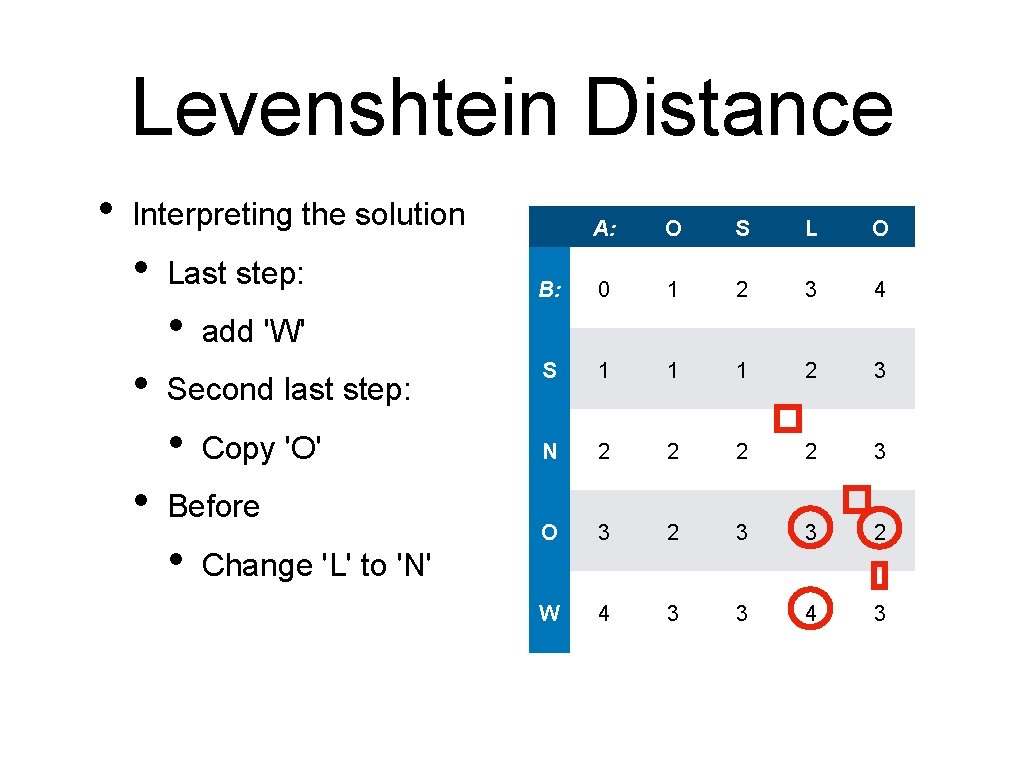
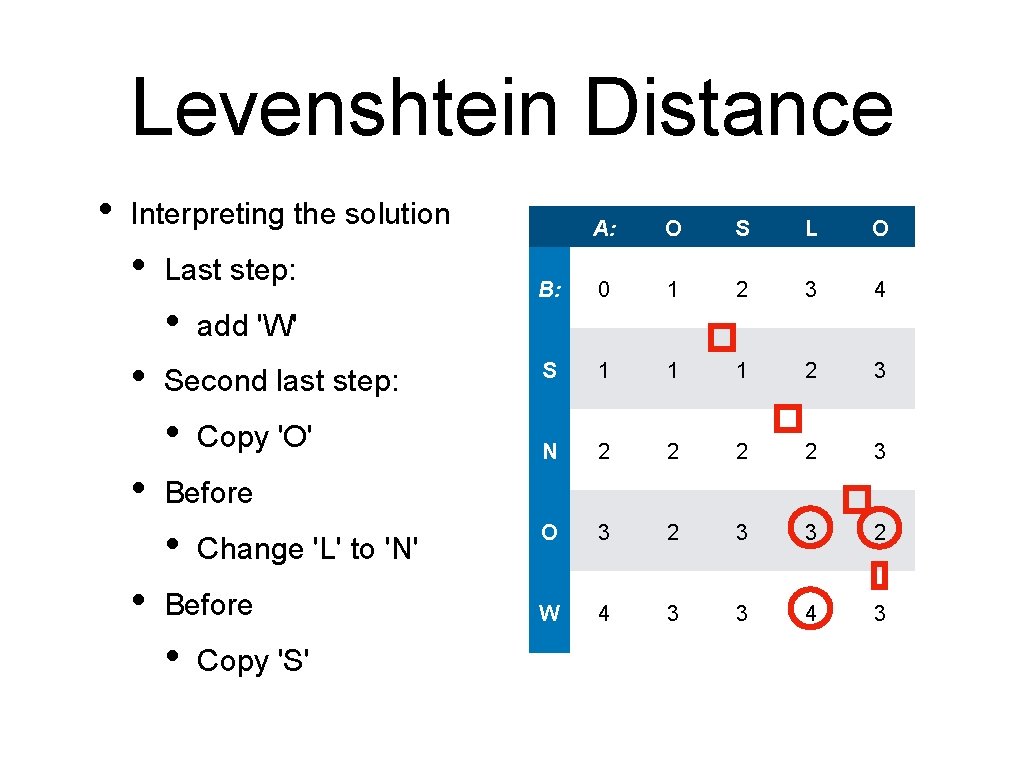
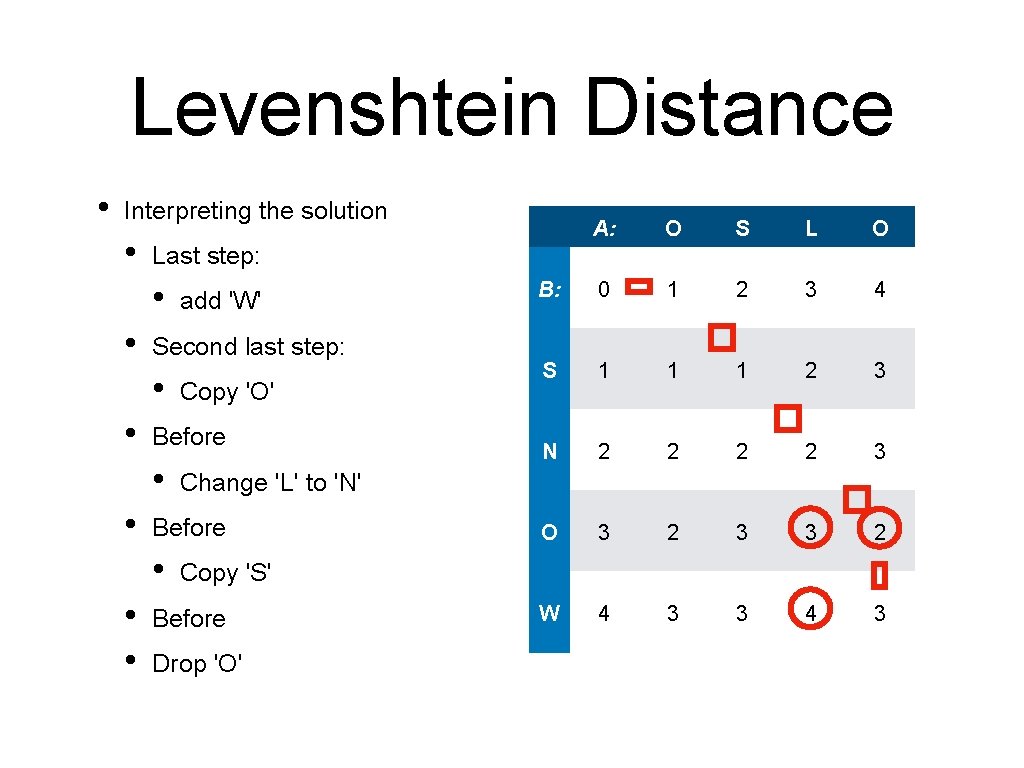
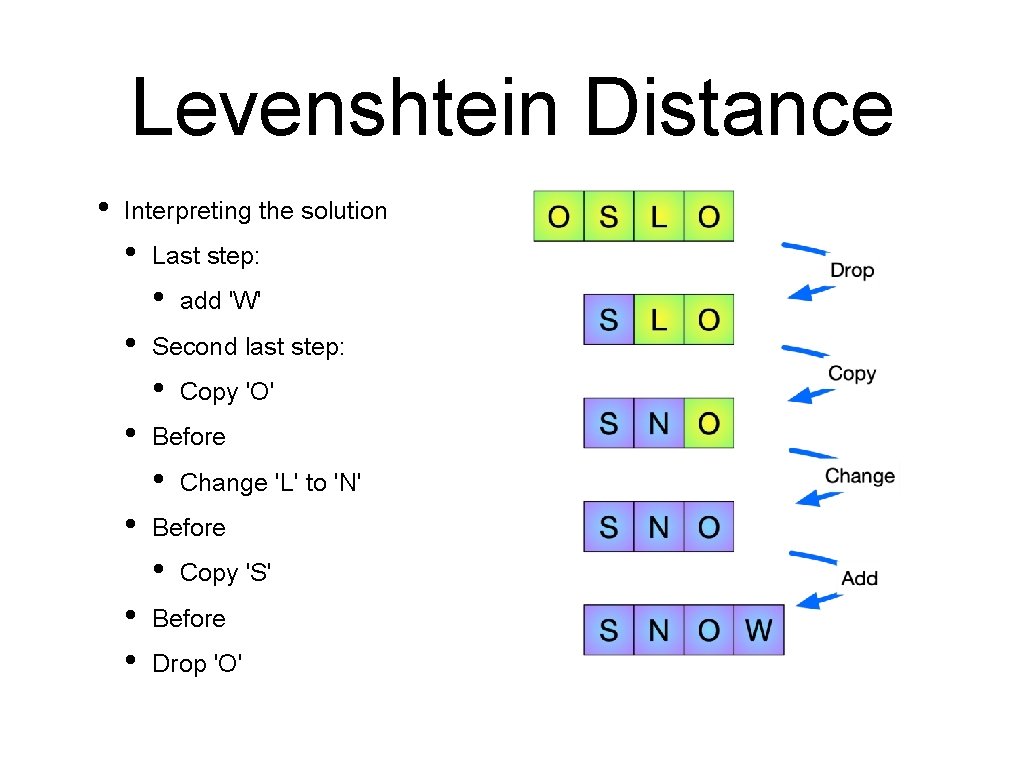
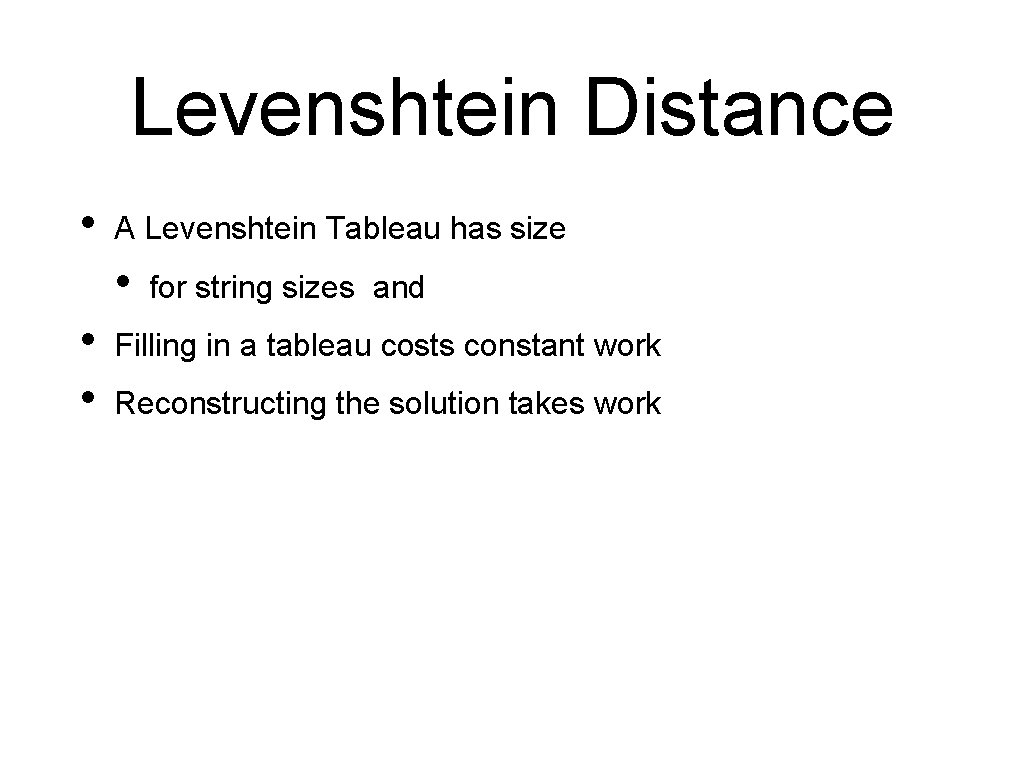
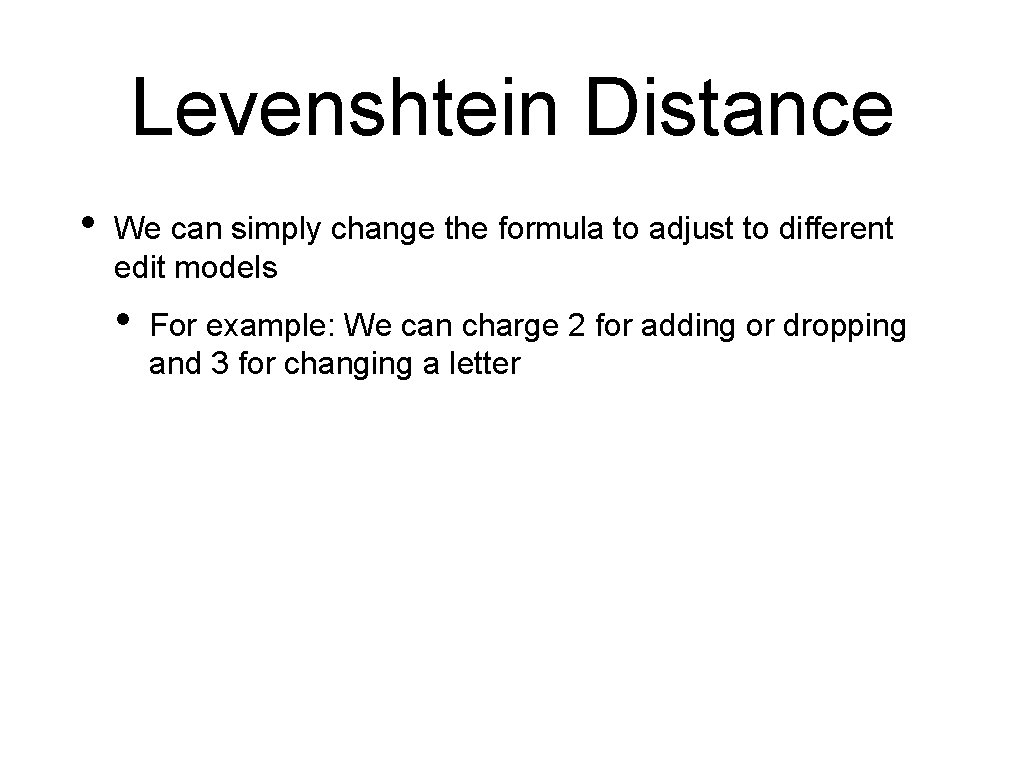
- Slides: 200

Dynamic Programming Algorithms

Definition • A quite generic strategy that reduces the solution of a problem to the solution of similar subproblems • • Divide and conquer: • Division leads to a recursion subject to the Master Theorem • Generate two or more subproblems General dynamic programming: • • In general, no division but a reduction of problem size Leads often to super-polynomial algorithms

Definition • Key technique: • Memoization • • Previously obtained results are cached Tabulation • Solve all previous problems and put them into a table

Usage • Dynamic programming is very generic • • Often, does not lead to poly-time algorithms • I. e. an NP-complete problem Used often when problems need to be solved even though it is known that a good scalable algorithm is unavailable

Example 1 Forming sums • Determine the number of ways we can write a number n as a sum of ones and twos (not using commutativity) • Example: • Five possibilities

Example 1 Forming sums • Idea: • • Sum ends with either a +1 or a +2 The part before sums to n-1 or n-2 respectively

Example 1 Forming sums • • • Idea: The ways to write n are given by writing n-2 and n-1 Number of ways for n: Recursion formula: • Fibonacci numbers!

Example 1 Forming sums • Extend to sums with 1, 2, 3: • Your turn

Example 1 Forming sums • Solution

Example 2 Dominoes • Count the number of ways in which a filled with domino stones of size field can be

Example 2 Dominoes • Can we reduce the problem to simpler ones? • • number of tessellations for an area There is a problem for the reduction • We can make progress with five different stacks

Example 2 Dominoes • Cannot just assume that we progress by two

• Example 2 Dominoes Need to introduce two more shapes Number of tessel of this type

Example 2 Dominoes • • Need recursions for all three T can be generated from a T, a B and an A

Example 2 Dominoes • To generate a type A there are only two possibilities

Example 2 Dominoes • Similarly: Type B can be generated from a Type B and a Type T

Example 2 Dominoes • Need to give base cases: • • •

Example 2 Dominoes • Now we can calculate:

Example 2 Dominoes

Example 2 Dominoes •

Example 2 Dominos • If you have a domino set (or two) try out to generate them all • If we continue, we notice that if the number of columns is odd, there is no tiling.

Implementing Dominos • Method 1: Tabulation n T A B • • • 0 0 1 0 1 1 2 3 0 0 Create three arrays for A, B, and T Seed them with the initial values Then calculate 3 4 5 6 7 8 9

Implementing Dominos • Method 1: Tabulation n T A B • • • 0 0 1 0 1 1 2 3 0 0 Create three arrays for A, B, and T Seed them with the initial values Then calculate 3 • • 4 T[3] = T[1]+A[2]+B[2] The needed values are already in the table 5 6 7 8 9

Implementing Dominos • Method 1: Tabulation n T A B • • • 0 0 1 0 1 1 2 3 0 0 Then calculate 3 0 4 • • 4 Create three arrays for A, B, and T Seed them with the initial values A[3] =A[1]+T[2] The needed values are already in the table 5 6 7 8 9

Implementing Dominos • Method 1: Tabulation n T A B • • • 0 0 1 0 1 1 2 3 0 0 Then calculate 3 0 4 4 • • 4 11 0 0 5 0 15 15 6 41 0 7 0 56 56 Create three arrays for A, B, and T Seed them with the initial values A[3] =A[1]+T[2] The needed values are already in the table 8 153 0 9 0 0 0 209

Implementing Dominoes • We can do this in Python as well • In order not to get confused with indexing, I generate arrays that are filled with zeroes but for the initial values def dominoes(n): A = [0, 1, 0] B = [0, 1, 0] T = [0, 0, 3] for _ in range(n-2): A. append(0) B. append(0) T. append(0) for i in range(3, n+1): T[i] = T[i-2]+A[i-1]+B[i-1] A[i] = T[i-1]+A[i-2] B[i] = T[i-1]+B[i-2]

Implementing Dominoes • This can be improved. • • • Filling with zeroes is for zombies A and B array of course have the same contents, so we only need one However, an exploding function like this one is deeply satisfying. • There are 7424580412223196202895949384810803026794570617631909 0761116688186653851995337727026406360492909388239325 3033609205329571467793832497625768032973504282592233 2254742656185337688282886926827702457299195194779497 9833056759937457969374171147406013771281953652344229 11247446963166340427777721 tessellations of a 1000 by 3 field

Implementing Dominoes • Method 2: Memoization (sic) • We really have a system of recurrences here • • • after getting rid of the A-copy B So, we could use recursion • This will actually work, because we never calculate the same value twice.

Implementing Dominoes def t(n): if n < 2: return 0 if n == 2: return 3 else: return t(n-2)+2*a(n-1) def a(n): if n<1: return 0 if n==1: return 1 else: return a(n-2)+t(n-1)

Implementing Dominoes • But remember recursive Fibonacci? • • We could spend a lot of time recalculating values This is where memoization comes in. • • Remember all of the previous values in a dictionary In our case, we need one dictionary for T values and another for A values

Implementing Dominoes • Let's speed up Fibonacci number calculation def recfib(n): if n < 2: return n else: return recfib(n-1)+recfib(n-2)

Implementing Dominoes • • • We want to remember the recursive results Create a dictionary with partially filled in values When we calculate recursively • See whether a requested value is already in the dictionary • Add any calculated value to the dictionary

Implementing Dominoes • Defining the dictionary • Step 1: Declare the dictionary • Dictionary needs to stay the same between different calls to recfib, so it cannot be a local variable • We can but do not need to use global • Because dictionaries are called by reference, we can change them from within a function

Implementing Dominoes fibdic={0: 0, 1: 1} Dictionary is defined outside the function's body def memfib(n): global fibdic if n in fibdic: return fibdic[n] else: value = memfib(n-1)+memfib(n-2) fibdic[n]=value return value

Implementing Dominoes fibdic={0: 0, 1: 1} The base case is now encoded in the dictionary def memfib(n): global fibdic if n in fibdic: return fibdic[n] else: value = memfib(n-1)+memfib(n-2) fibdic[n]=value return value

Implementing Dominoes fibdic={0: 0, 1: 1} This is not really necessary Scope rules would find fibdic def memfib(n): global fibdic if n in fibdic: return fibdic[n] else: value = memfib(n-1)+memfib(n-2) fibdic[n]=value return value

Implementing Dominoes fibdic={0: 0, 1: 1} First look for the value in the dictionary. def memfib(n): global fibdic if n in fibdic: return fibdic[n] else: value = memfib(n-1)+memfib(n-2) fibdic[n]=value return value

Implementing Dominoes fibdic={0: 0, 1: 1} When we do a calculation, we need to do two def memfib(n): things: global fibdic (1) Update the dictionary if n in fibdic: (2) Return the result return fibdic[n] else: value = memfib(n-1)+memfib(n-2) fibdic[n]=value return value

Implementing Dominoes fibdic={0: 0, 1: 1} def memfib(n): global fibdic (1) Update the dictionary if n in fibdic: return fibdic[n] else: value = memfib(n-1)+memfib(n-2) fibdic[n]=value return value

Implementing Dominoes fibdic={0: 0, 1: 1} def memfib(n): global fibdic (2) Return the result if n in fibdic: return fibdic[n] else: value = memfib(n-1)+memfib(n-2) fibdic[n]=value return value

Implementing Dominoes • This now runs much faster • And the dictionary persists between calls

Implementing Memoization • In Python, define a decorator • A decorator applies a function on a function to be defined • When the function is called, the function of the function is instead called • Same function can apply to many different functions

Implementing Memoization def memoize_function(f): The outer function memory = {} def inner(num): if num not in memory: memory[num] = f(num) return memory[num] return inner

Implementing Memoization memory is available inside the full scope of def memoize_function(f): memoize_function memory = {} def inner(num): if num not in memory: memory[num] = f(num) return memory[num] return inner

Implementing Memoization inner is the function that we return def memoize_function(f): memory = {} def inner(num): if num not in memory: memory[num] = f(num) return memory[num] return inner

Implementing Memoization inner is the function that we return def memoize_function(f): memory = {} def inner(num): if num not in memory: memory[num] = f(num) return memory[num] return inner

Implementing Memoization inner is the function that we return def memoize_function(f): memory = {} def inner(num): if num not in memory: memory[num] = f(num) return memory[num] return inner

Implementing Memoization @memoize_function This is a decorator Just write @ and the name of the function of a function def fib(n): if n < 0: return 0 if n <= 1: return n else: return fib(n-1)+fib(n-2)

Implementing Memoization @memoize_function This is the normal recursive function def fib(n): if n < 0: Without the decorator, it would run very slowly, but now it is very fast. return 0 if n <= 1: return n else: return fib(n-1)+fib(n-2)

Dynamic Programming • Three steps: • • • Define sub-problems Set-up a recursion Determine base cases

Knapsack Problem • Continuous knapsack problem • • Select items from set Each item has a weight Each item has a value Maximize • with subject to

Continuous Knapsack Problem • Story: • • You have sent a mining robot to an asteroid. • You have one last freight to send to earth with a capacity of 10 tons. Mining asteroids has been suspended by the world government and on April 1 st, you need to abandon all activity • You mining operation has yielded: • • • 2 tons paladium ($2600 per ounce) 7 tons platinum ($750 per ounce) 3 tons gold ($1700 per ounce) 4 tons silver ($15 per ounce) What do you select for your final journey

Continuous Knapsack Problem • Solution: • You load the rocket with what you have in order of preciousness: • All the Paladium, all the gold, and what you can of the platinum

Knapsack Problem • Continuous knapsack problem • Greedy algorithm solves the continuous knapsack algorithm: • Order items by ratios of value over weight • Select items in order of this ratio • • As long as remaining under capacity Last item might be fractional

Knapsack Problem • Example • Item Value Weight Ratio A 9 5 1. 80 B 7 4 1. 75 C 6 4 1. 5 D 3 2 1. 5 E 2 2 1 F 1 1 1 Total capacity is 6

Knapsack Problem • Example • • Item Value Weight Ratio A 9 5 1. 80 B 7 4 1. 75 C 6 4 1. 5 D 3 2 1. 5 E 2 2 1 F 1 1 1 Total capacity is 6, total value is 10. 75

Knapsack Problem • 0 -1 knapsack • • Can select only an entire item, but not a fraction Greedy method is no longer best

Knapsack Problem • 0 -1 knapsack • • Story: • • You are the director of the Louvre • You estimate that you can move 10 tons of art to a safe place in the time you have left • Which pieces do you select? You are told that there is an asteroid crashing into the museum in 5 hours If you start with the most conspicuous items, you select the Nike of Samothrace, Mona Lisa, and your Rubens collection • But if you give up on the multi-ton Nike of Samothrace, you can safe almost all of the famous paintings you have

Knapsack Problem • Example • Item Value Weight Ratio A 9 5 1. 80 B 7 4 1. 75 C 6 4 1. 5 D 3 2 1. 5 E 2 2 1 F 1 1 1 Total capacity is 6

Knapsack Problem • Example • Value Weight Ratio A 9 5 1. 80 B 7 4 1. 75 C 6 4 1. 5 D 3 2 1. 5 E 2 2 1 Greedy solution: • • Item Select only A Total weight is 5 and total gain is 9

Knapsack Problem • Example • Value Weight Ratio A 9 5 1. 80 B 7 4 1. 75 C 6 4 1. 5 D 3 2 1. 5 E 2 2 1 F 1 1 1 Better solution: • • Item Include B and D Total weight is 6 and total value is 10

Knapsack Problem • One possibility: • Enumerate and evaluate all possible combinations of items • This means checking combinations of items • • One for each subset. Solving knapsack problems with dynamic programming • • • Sub-problems? Recursion? Base Case?

Knapsack Problem • Sub-problems • Optimal solution needs to be composed of solutions for subproblems • Use less items, use fewer capacities

Knapsack Problem • • Order all items in any order Optimal solution: • Two alternatives: • • Last item is included Last item is not included

Knapsack Problem • Order all items in any order • Optimal solution: • Two alternatives: • Last item is included • Before inclusion of the last item • • Solved knapsack for all but last item with total capacity minus weight of last item Last item is not included • Before non-inclusion of the last item • Solved knapsack for all but last item with total capacity

Knapsack Problem • Generate Table • Columns: set of items is • Rows: Capacity below problem capacity

Knapsack Problem • Example • Item Value Weight Ratio A 9 5 1. 80 B 7 4 1. 75 C 6 4 1. 5 D 3 2 1. 5 E 2 2 1 F 1 1 1 Total capacity is 6

Knapsack Problem • Example Item Value Weight Ratio A 9 5 1. 80 B 7 4 1. 75 C 6 4 1. 5 D 3 2 1. 5 E 2 2 1 F 1 1 1 • Cell in column {A, … , X} and row r is the gain of selecting from {A, … , X} and maximum capacity r

Knapsack Problem • Element in row r and columns Xi

Knapsack Problem • Base cases: • • No items to select: gain is zero Capacity is zero: gain is zero

Knapsack Problem • Work forward adding column after column • Item A has weight 5 and value 9

Knapsack Problem • Item B has weight 4 and value 7

Knapsack Problem • Item C has value 6 and weight 4

Knapsack Problem • Item D has weight 2 and value 3

Knapsack Problem • Item E has weight 2 and value 2

Knapsack Problem • Item F has weight 1 and value 1

Knapsack Problem • Final table tells us the realizable total value • but not how to obtain it

Knapsack Problem • Can either annotate table entry with how we got them • or can backtrack

Knapsack Problem • Backtracking • Last entry is either with or without including F

Knapsack Problem • Backtracking • Let’s say we include it

Knapsack Problem • Backtracking • Then the 10 was realized as 9+1 with the previous column and row - weight of item F =1

Knapsack Problem • Backtracking • No such choice with the other ones until we get to A

Knapsack Problem • Backtracking • Included A and F for a total value of 10 and a total weight of 6

Knapsack Problem • Backtracking alternative in the first step: • Don’t include F, E, D

Knapsack Problem • Backtracking • must have included item D

Knapsack Problem • Backtracking • D has value 3 and weight 2

Knapsack Problem • Backtracking • Do not include C

Knapsack Problem • Backtracking • But include B

Knapsack Problem • Backtracking • • and therefore not A Alternative solution: Select B and D for the same total value and capacity

Knapsack Problem • Your turn: Extend to total capacity 10 Item Value Weight A 9 5 B 7 4 C 6 4 D 3 2 E 2 2 F 1 1

Knapsack Problem Include F

Knapsack Problem Include F Do not include E

Knapsack Problem Include F Do not include E Do not include D

Knapsack Problem Include Do not include F E D C

Knapsack Problem Include Do not include Include F E D C B

Knapsack Problem Include Do not include Include F E D C B A

0 -1 Knapsack Example • An alternative to backtracking is to store the information in the table Item Valu Weight e A 10 5 B 9 4 C 8 4 D 7 4 E 7 3 F 4 2 G 3 2 H 1 2 Total Capacity 10

0 -1 Knapsack Example • Create the table and initialize it / Valu Item Weight e 0 0 1 0 2 0 3 0 4 0 A 10 5 B 9 4 C 8 4 D 7 4 5 0 E 7 3 6 0 F 4 2 7 0 G 3 2 H 1 2 8 0 9 0 10 0 Total Capacity 10 A B C D E F G

0 -1 Knapsack Example • • The column for A is simple. Red means: item included Valu Item Weight e / A 0 0 0 1 0 0 2 0 0 3 0 0 4 0 0 A 10 5 B 9 4 C 8 4 D 7 4 5 0 10 E 7 3 6 0 10 F 4 2 7 0 10 G 3 2 H 1 2 8 0 10 9 0 10 10 Total Capacity 10 B C D E F G

0 -1 Knapsack Example • • The column for A is simple. Red means: item included Valu Item Weight e / A B 0 0 1 0 0 0 2 0 0 0 3 0 0 0 4 0 0 9 C D A 10 5 B 9 4 C 8 4 D 7 4 5 0 10 10 max(10, 9) E 7 3 6 0 10 10 F 4 2 7 0 10 10 G 3 2 H 1 2 8 0 10 10 9 0 10 19 10 0 10 19 Total Capacity 10 E F G

0 -1 Knapsack Example Valu Item Weight e / A B C 0 0 0 1 0 0 2 0 0 3 0 0 4 0 0 9 9 10 A 10 5 B 9 4 C 8 4 D 7 4 5 0 10 10 E 7 3 6 0 10 10 F 4 2 7 0 10 10 G 3 2 H 1 2 8 0 10 10 9 0 10 19 10 0 10 19 Total Capacity 10 D E F G 10 = max(10, 0+8)

0 -1 Knapsack Example Valu Item Weight e / A B C 0 0 0 1 0 0 2 0 0 3 0 0 4 0 0 9 9 A 10 5 B 9 4 C 8 4 D 7 4 5 0 10 10 10 E 7 3 6 0 10 10 10 F 4 2 7 0 10 10 10 G 3 2 H 1 2 8 0 10 10 17 9 0 10 19 19 10 0 10 19 19 Total Capacity 10 D E F G 17 = max(10, 9 + 8)

0 -1 Knapsack Example Valu Item Weight e / A B C D 0 0 0 1 0 0 0 2 0 0 0 3 0 0 0 4 0 0 9 9 9 E F G A 10 5 B 9 4 C 8 4 D 7 4 5 0 10 10 E 7 3 6 0 10 10 F 4 2 7 0 10 10 G 3 2 H 1 2 8 0 10 10 17 17 9 0 10 19 1917 = max(17, 9 + 7) 10 0 10 19 19 Total Capacity 10

0 -1 Knapsack Example Valu Item Weight e / A B C D E 0 0 0 0 1 0 0 0 2 0 0 0 3 0 0 0 7 4 0 0 9 9 F G A 10 5 B 9 4 C 8 4 D 7 4 5 0 10 10 9 7 = max(0, 7) 10 10 E 7 3 6 0 10 10 F 4 2 7 0 10 10 G 3 2 H 1 2 8 0 10 10 17 17 9 0 10 19 19 19 10 0 10 19 19 19 Total Capacity 10

0 -1 Knapsack Example Valu Item Weight e / A B C D E 0 0 0 0 1 0 0 0 2 0 0 0 3 0 0 0 7 4 0 0 9 9 F G A 10 5 B 9 4 C 8 4 D 7 4 5 0 10 10 10 9 10 = max(9, 7) E 7 3 6 0 10 10 F 4 2 7 0 10 10 G 3 2 H 1 2 8 0 10 10 17 17 9 0 10 19 19 19 10 0 10 19 19 19 Total Capacity 10

0 -1 Knapsack Example Valu Item Weight e / A B C D E 0 0 0 0 1 0 0 0 2 0 0 0 3 0 0 0 7 4 0 0 9 9 F G A 10 5 B 9 4 C 8 4 D 7 4 5 0 10 10 10 E 7 3 6 0 10 10 10 F 4 2 7 0 10 10 16 G 3 2 H 1 2 8 0 10 10 17 17 17 9 0 10 19 19 19 10 0 This 10 19 is 19 a 19 tie! Break it as you wish Total Capacity 10

0 -1 Knapsack Example Valu Item Weight e / A B C D E 0 0 0 0 1 0 0 0 2 0 0 0 3 0 0 0 7 4 0 0 9 9 A 10 5 B 9 4 C 8 4 D 7 4 5 0 10 10 10 E 7 3 6 0 10 10 10 F 4 2 7 0 10 10 16 G 3 2 H 1 2 8 0 10 10 17 17 17 9 0 10 19 19 10 0 10 19 19 Total Capacity 10 F G

0 -1 Knapsack Example Valu Item Weight e / A B C D E F 0 0 0 0 1 0 0 0 0 2 0 0 0 4 3 0 0 0 7 7 4 0 0 9 9 9 A 10 5 B 9 4 C 8 4 D 7 4 5 0 10 10 E 7 3 6 0 10 10 10 F 4 2 7 0 10 10 16 G 3 2 H 1 2 8 0 10 10 17 17 17 9 0 10 19 19 10 0 10 19 19 Total Capacity 10 G 10 max(9, 0+4)

0 -1 Knapsack Example Valu Item Weight e / A B C D E F 0 0 0 0 1 0 0 0 0 2 0 0 0 4 3 0 0 0 7 7 4 0 0 9 9 9 10 11 A 10 5 B 9 4 C 8 4 D 7 4 5 0 10 10 E 7 3 6 0 10 10 F 4 2 7 0 10 10 16 G 3 2 H 1 2 8 0 10 10 17 17 17 9 0 10 19 19 10 0 10 19 19 Total Capacity 10 G max(10, 7+4) 10

0 -1 Knapsack Example Valu Item Weight e / A B C D E F 0 0 0 0 1 0 0 0 0 2 0 0 0 4 3 0 0 0 7 7 4 0 0 9 9 9 A 10 5 B 9 4 C 8 4 D 7 4 5 0 10 10 11 E 7 3 6 0 10 10 13 F 4 2 7 0 10 10 10 G 3 2 10 16 max(10, H 1 2 8 0 10 10 17 17 17 9 0 10 19 19 10 0 10 19 19 Total Capacity 10 G 9+4)

0 -1 Knapsack Example Valu Item Weight e / A B C D E F 0 0 0 0 1 0 0 0 0 2 0 0 0 4 3 0 0 0 7 7 4 0 0 9 9 9 A 10 5 B 9 4 C 8 4 D 7 4 5 0 10 10 11 E 7 3 6 0 10 10 13 F 4 2 7 0 10 10 16 16 G 3 2 H 1 2 8 0 10 10 17 17 17 max(16, 9 0 10 19 19 10 0 10 19 19 Total Capacity 10 G 10+4)

0 -1 Knapsack Example Valu Item Weight e / A B C D E F 0 0 0 0 1 0 0 0 0 2 0 0 0 4 3 0 0 0 7 7 4 0 0 9 9 9 A 10 5 B 9 4 C 8 4 D 7 4 5 0 10 10 11 E 7 3 6 0 10 10 13 F 4 2 7 0 10 10 16 16 G 3 2 H 1 2 8 0 10 10 17 17 9 0 10 19 19 19 max(17, 19 10 0 10 19 19 19 Total Capacity 10 19 G 10+4)

0 -1 Knapsack Example Valu Item Weight e / A B C D E F 0 0 0 0 1 0 0 0 0 2 0 0 0 4 3 0 0 0 7 7 4 0 0 9 9 9 A 10 5 B 9 4 C 8 4 D 7 4 5 0 10 10 11 E 7 3 6 0 10 10 13 F 4 2 7 0 10 10 16 16 G 3 2 H 1 2 8 0 10 10 17 17 9 0 10 19 19 20 10 19 19 max(19, 19 19 Total Capacity 10 G 16+4)

0 -1 Knapsack Example Valu Item Weight e / A B C D E F 0 0 0 0 1 0 0 0 0 2 0 0 0 4 3 0 0 0 7 7 4 0 0 9 9 9 A 10 5 B 9 4 C 8 4 D 7 4 5 0 10 10 11 E 7 3 6 0 10 10 13 F 4 2 7 0 10 10 16 16 G 3 2 H 1 2 8 0 10 10 17 17 9 0 10 19 19 20 10 19 19 21 Total Capacity 10 G max(19, 17+4)

0 -1 Knapsack Example Valu Item Weight e / A B C D E F G 0 0 0 0 0 1 0 0 0 0 2 0 0 0 4 4 3 0 0 0 7 7 7 4 0 0 9 9 9 A 10 5 B 9 4 C 8 4 D 7 4 5 0 10 10 11 E 7 3 6 0 10 10 13 F 4 2 7 0 10 10 16 16 G 3 2 H 1 2 8 0 10 10 17 17 9 0 10 19 19 20 10 19 19 21 Total Capacity 10 H max(9, 4+3)

0 -1 Knapsack Example Valu Item Weight e / A B C D E F G 0 0 0 0 0 1 0 0 0 0 2 0 0 0 4 4 3 0 0 0 7 7 7 4 0 0 9 9 9 A 10 5 B 9 4 C 8 4 D 7 4 5 0 10 10 11 11 E 7 3 6 0 10 10 13 F 4 2 7 0 10 10 16 16 G 3 2 H 1 2 8 0 10 10 17 17 9 0 10 19 19 20 10 19 19 21 Total Capacity 10 H max(11, 7+3)

0 -1 Knapsack Example Valu Item Weight e / A B C D E F G 0 0 0 0 0 1 0 0 0 0 2 0 0 0 4 4 3 0 0 0 7 7 7 4 0 0 9 9 9 A 10 5 B 9 4 C 8 4 D 7 4 5 0 10 10 11 11 E 7 3 6 0 10 10 13 13 F 4 2 7 0 10 10 16 16 G 3 2 H 1 2 8 0 10 10 17 max(13, 17 17 17 9 0 10 19 19 20 10 19 19 21 Total Capacity 10 H 9+3)

0 -1 Knapsack Example Valu Item Weight e / A B C D E F G 0 0 0 0 0 1 0 0 0 0 2 0 0 0 4 4 3 0 0 0 7 7 7 4 0 0 9 9 9 A 10 5 B 9 4 C 8 4 D 7 4 5 0 10 10 11 11 E 7 3 6 0 10 10 13 13 F 4 2 7 0 10 10 16 16 16 G 3 2 H 1 2 8 0 10 10 17 17 9 0 10 19 19 20 10 19 19 21 Total Capacity 10 H max(16, 11+3)

0 -1 Knapsack Example Valu Item Weight e / A B C D E F G 0 0 0 0 0 1 0 0 0 0 2 0 0 0 4 4 3 0 0 0 7 7 7 4 0 0 9 9 9 A 10 5 B 9 4 C 8 4 D 7 4 5 0 10 10 11 11 E 7 3 6 0 10 10 13 13 F 4 2 7 0 10 10 16 16 16 G 3 2 H 1 2 8 0 10 10 17 17 17 9 0 10 19 19 20 10 19 19 21 Total Capacity 10 H max(17, 13+3)

0 -1 Knapsack Example Valu Item Weight e / A B C D E F G 0 0 0 0 0 1 0 0 0 0 2 0 0 0 4 4 3 0 0 0 7 7 7 4 0 0 9 9 9 H A 10 5 B 9 4 C 8 4 D 7 4 5 0 10 10 11 11 E 7 3 6 0 10 10 13 13 F 4 2 7 0 10 10 16 16 16 G 3 2 H 1 2 8 0 10 10 17 17 17 9 0 10 19 19 20 20 10 19 19 2116+3) max(20, Total Capacity 10

0 -1 Knapsack Example Valu Item Weight e / A B C D E F G 0 0 0 0 0 1 0 0 0 0 2 0 0 0 4 4 3 0 0 0 7 7 7 4 0 0 9 9 9 A 10 5 B 9 4 C 8 4 D 7 4 5 0 10 10 11 11 E 7 3 6 0 10 10 13 13 F 4 2 7 0 10 10 16 16 16 G 3 2 H 1 2 8 0 10 10 17 17 17 9 0 10 19 19 20 20 10 19 19 21 21 Total Capacity 10 H max(21, 17+3)

0 -1 Knapsack Example Valu Item Weight e / A B C D E F G 0 0 0 0 0 1 0 0 0 0 2 0 0 0 4 4 3 0 0 0 7 7 7 4 0 0 9 9 9 H A 10 5 B 9 4 C 8 4 D 7 4 5 0 10 10 11 11 E 7 3 6 0 10 10 13 13 F 4 2 7 0 10 10 16 16 16 G 3 2 H 1 2 8 0 10 10 17 17 17 9 0 10 19 19 20 20 10 19 19 21 21 21 Total Capacity 10 max(21, 17+1)

0 -1 Knapsack Example • Backtracking is now easier Valu Item Weight e / A B C D E F G 0 0 0 0 0 1 0 0 0 0 2 0 0 0 4 4 3 0 0 0 7 7 7 4 0 0 9 9 9 H A 10 5 B 9 4 C 8 4 D 7 4 5 0 10 10 11 11 E 7 3 6 0 10 10 13 13 F 4 2 7 0 10 10 16 16 16 G 3 2 H 1 2 8 0 10 10 17 17 17 9 0 10 19 19 20 20 10 19 19 21 21 21 Total Capacity 10

0 -1 Knapsack Example • Do not include H Valu Item Weight e / A B C D E F G 0 0 0 0 0 1 0 0 0 0 2 0 0 0 4 4 3 0 0 0 7 7 7 4 0 0 9 9 9 H A 10 5 B 9 4 C 8 4 D 7 4 5 0 10 10 11 11 E 7 3 6 0 10 10 13 13 F 4 2 7 0 10 10 16 16 16 G 3 2 H 1 2 8 0 10 10 17 17 17 9 0 10 19 19 20 20 10 19 19 21 21 21 Total Capacity 10

0 -1 Knapsack Example • Do not include G Valu Item Weight e / A B C D E F G 0 0 0 0 0 1 0 0 0 0 2 0 0 0 4 4 3 0 0 0 7 7 7 4 0 0 9 9 9 H A 10 5 B 9 4 C 8 4 D 7 4 5 0 10 10 11 11 E 7 3 6 0 10 10 13 13 F 4 2 7 0 10 10 16 16 16 G 3 2 H 1 2 8 0 10 10 17 17 17 9 0 10 19 19 20 20 10 19 19 21 21 21 Total Capacity 10

0 -1 Knapsack Example • Do include F Valu Item Weight e / A B C D E F G 0 0 0 0 0 1 0 0 0 0 2 0 0 0 4 4 3 0 0 0 7 7 7 4 0 0 9 9 9 H A 10 5 B 9 4 C 8 4 D 7 4 5 0 10 10 11 11 E 7 3 6 0 10 10 13 13 F 4 2 7 0 10 10 16 16 16 G 3 2 H 1 2 8 0 10 10 17 17 17 9 0 10 19 19 20 20 10 19 19 21 21 21 Total Capacity 10

0 -1 Knapsack Example • Do include F • F has weight 2 Valu Item Weight e / A B C D E F G 0 0 0 0 0 1 0 0 0 0 2 0 0 0 4 4 H A 10 5 3 0 0 0 7 7 7 B 9 4 4 0 0 9 9 9 C 8 4 D 7 4 5 0 10 10 11 11 E 7 3 6 0 10 10 13 13 F 4 2 7 0 10 10 16 16 16 G 3 2 8 0 10 10 17 17 17 H 1 2 9 0 10 19 19 20 20 10 19 19 21 21 21 Total Capacity 10

0 -1 Knapsack Example • Do include F • F has weight 2 Valu Item Weight e / A B C D E F G 0 0 0 0 0 1 0 0 0 0 2 0 0 0 4 4 H A 10 5 3 0 0 0 7 7 7 B 9 4 4 0 0 9 9 9 C 8 4 D 7 4 5 0 10 10 11 11 E 7 3 6 0 10 10 13 13 F 4 2 7 0 10 10 16 16 16 G 3 2 8 0 10 10 17 17 17 H 1 2 9 0 10 19 19 20 20 10 19 19 21 21 21 Total Capacity 10

0 -1 Knapsack Example • Do not include E Valu Item Weight e / A B C D E F G 0 0 0 0 0 1 0 0 0 0 2 0 0 0 4 4 H A 10 5 3 0 0 0 7 7 7 B 9 4 4 0 0 9 9 9 C 8 4 D 7 4 5 0 10 10 11 11 E 7 3 6 0 10 10 13 13 F 4 2 7 0 10 10 16 16 16 G 3 2 8 0 10 10 17 17 17 H 1 2 9 0 10 19 19 20 20 10 19 19 21 21 21 Total Capacity 10

0 -1 Knapsack Example • Do not include D Valu Item Weight e / A B C D E F G 0 0 0 0 0 1 0 0 0 0 2 0 0 0 4 4 H A 10 5 3 0 0 0 7 7 7 B 9 4 4 0 0 9 9 9 C 8 4 D 7 4 5 0 10 10 11 11 E 7 3 6 0 10 10 13 13 F 4 2 7 0 10 10 16 16 16 G 3 2 8 0 10 10 17 17 17 H 1 2 9 0 10 19 19 20 20 10 19 19 21 21 21 Total Capacity 10

0 -1 Knapsack Example • Do include C Valu Item Weight e / A B C D E F G 0 0 0 0 0 1 0 0 0 0 2 0 0 0 4 4 H A 10 5 3 0 0 0 7 7 7 B 9 4 4 0 0 9 9 9 C 8 4 D 7 4 5 0 10 10 11 11 E 7 3 6 0 10 10 13 13 F 4 2 7 0 10 10 16 16 16 G 3 2 8 0 10 10 17 17 17 H 1 2 9 0 10 19 19 20 20 10 19 19 21 21 21 Total Capacity 10

0 -1 Knapsack Example • Do include C • C has weight 4 Valu Item Weight e / A B C D E F G 0 0 0 0 0 1 0 0 0 0 2 0 0 0 4 4 H A 10 5 3 0 0 0 7 7 7 B 9 4 4 0 0 9 9 9 C 8 4 D 7 4 5 0 10 10 11 11 E 7 3 6 0 10 10 13 13 F 4 2 7 0 10 10 16 16 16 G 3 2 8 0 10 10 17 17 17 H 1 2 9 0 10 19 19 20 20 10 19 19 21 21 21 Total Capacity 10

0 -1 Knapsack Example • Do include B Valu Item Weight e / A B C D E F G 0 0 0 0 0 1 0 0 0 0 2 0 0 0 4 4 H A 10 5 3 0 0 0 7 7 7 B 9 4 4 0 0 9 9 9 C 8 4 D 7 4 5 0 10 10 11 11 E 7 3 6 0 10 10 13 13 F 4 2 7 0 10 10 16 16 16 G 3 2 8 0 10 10 17 17 17 H 1 2 9 0 10 19 19 20 20 10 19 19 21 21 21 Total Capacity 10

0 -1 Knapsack Example • Do include B • B has weight 4 Valu Item Weight e / A B C D E F G 0 0 0 0 0 1 0 0 0 0 2 0 0 0 4 4 H A 10 5 3 0 0 0 7 7 7 B 9 4 4 0 0 9 9 9 C 8 4 D 7 4 5 0 10 10 11 11 E 7 3 6 0 10 10 13 13 F 4 2 7 0 10 10 16 16 16 G 3 2 8 0 10 10 17 17 17 H 1 2 9 0 10 19 19 20 20 10 19 19 21 21 21 Total Capacity 10

0 -1 Knapsack Example • We have reached the upper row Valu Item Weight e / A B C D E F G 0 0 0 0 0 1 0 0 0 0 2 0 0 0 4 4 H A 10 5 3 0 0 0 7 7 7 B 9 4 4 0 0 9 9 9 C 8 4 D 7 4 5 0 10 10 11 11 E 7 3 6 0 10 10 13 13 F 4 2 7 0 10 10 16 16 16 G 3 2 8 0 10 10 17 17 17 H 1 2 9 0 10 19 19 20 20 10 19 19 21 21 21 Total Capacity 10

Knapsack Problem • Multiple Item Selection • When considering item j, need to look at including items • Formula changes

Knapsack Problem • Example: Items with value-weight of (26, 5), (20, 4), (14, 3), (9, 2), (4, 1)

Knapsack Problem (26, 5), (20, 4), (14, 3), (9, 2), (4, 1)

Knapsack Problem (26, 5), (20, 4), (14, 3), (9, 2), (4, 1) Backtrack to find optimal selection

Knapsack Problem (26, 5), (20, 4), (14, 3), (9, 2), (4, 1) Optimal solution: 3 items of type A 1 item of type E

Matrix Chain Multiplication

Matrix Chain Multiplication • Given n integer matrices of various dimensions • Task is: multiply the matrices with the least number of multiplications of coefficients • We can change the order in which we execute the multiplications

Matrix Chain Multiplication • Different parenthesization have different costs • Parenthesization corresponds to different evaluation trees

Matrix Chain Multiplication • Dynamic programming approach • A product of n matrices is made up of one of the following • • • Product of 1 with product of n-1 matrices Product of 2 with product of n-2 matrices … Product of n-2 with product of 2 matrices Product of n-1 with product of 1 matrix

Matrix Chain Multiplication • Example: • • • A B C D E

Matrix Chain Multiplication • Start with product of two matrices in order

Matrix Chain Multiplication • Then products of three

Matrix Chain Multiplication • And products of four

Matrix Chain Multiplication • And finally the complete product

Matrix Chain Multiplication • How to best organize the calculation?

Matrix Chain Multiplication • Another way to look at it:

Matrix Chain Multiplication • • • Arrange the sizes of the matrices in an array sizes Matrix has sizes[i-1] x sizes[i] Recursively, define • m[i][j] if i==j = 0 = min([ m[i][k]+m[k+1][j] + sizes[i-1]sizes[k]sizes[j] for k in range(i, j)]) • To remember our choice for k, we mark it in an array • best[i][j] = k

Matrix Chain Multiplication • Implementation: • • We can either fill in the two arrays (m and best) Or we can use memoization with the recursion

Levenshtein Distance

Levenshtein Distance • Given two strings, find the shortest way of converting one to the other using • • • Insertion of a Character Deletion of a Character Substitution of a Character • If all these processes cost 1, then this is the Levenshtein distance • Important for approximate string matching, e. g. bioinformatics

Levenshtein Distance • Example • university —> anniversity —> anniversary

Levenshtein Distance • Dynamic Programming approach • Define sub-problems: • Smaller strings:

Levenshtein Distance • Dynamic Programming Approach • Case 1 a: Add the same letter • Distance does not change

Levenshtein Distance • Dynamic Programming • Case 1 B: Add a different letter • Distance increases by one

Levenshtein Distance • Dynamic Programming Approach • Case 2: Add a letter to string 1 • Increments distance

Levenshtein Distance • Dynamic Programming Approach • Case 3: • Add a letter to String 2

Levenshtein Distance • Dynamic Programming Approach • Strings are character arrays A, B • • Look at sub-strings delta(A[0: : i], B[0: : j]) Use an indicator function

Levenshtein Distance

Levenshtein Distance • Dynamic Programming Approach • • Base case If one string is empty, then the distance is the length of the other string

Levenshtein Distance • Dynamic Programming Approach • Bottom-up / Tabulation approach • Create a two dimensional table • • Fill in first row and first column with length of other string In order to find the edits without backtracking, mark where the value is coming from

Levenshtein Distance • Example • • Edit distance between OSLO and SNOW Fill in the first row / column 0 S 1 N 2 O 3 W 4 O S L O 1 2 3 4

Levenshtein Distance • Example • • O S L O 0 1 2 3 4 S 1 ? N 2 O 3 W 4 Edit distance between OSLO and SNOW Fill in the first row / column How to get from 'O' to 'S? '

Levenshtein Distance • Example • • A: O S L O 2 3 4 Edit distance between OSLO and SNOW B: 0 1 How to go from 'O' to 'S'? S 1 ? N 2 O 3 W 4 First choice: Go from "" to "S"; Add 'S' to the empty string:

Levenshtein Distance • Example • • A: O S L O 2 3 4 Edit distance between OSLO and SNOW B: 0 1 How to go from 'O' to 'S' S 1 ? N 2 O 3 W 4 Go from "" to "S" Add 'S'

Levenshtein Distance • Example A: O S L O 2 3 4 • Edit distance between OSLO and SNOW B: 0 1 • How to go from 'O' to 'S'? S 1 ? N 2 O 3 W 4 Went from "" to "" Now "O" to "S")

Levenshtein Distance • Example A: O S L O 2 3 4 • Edit distance between OSLO and SNOW B: 0 1 • • How to go from 'O' to 'S'? S 1 1 N 2 O 3 W 4 Starting with ' ' to ' ' (Switch "O" to "S")

Levenshtein Distance • Example • • Edit distance between OSLO and SNOW A: O S L O B: 0 1 2 3 4 S 1 1 ? N 2 O 3 W 4 Reduce from: • • • 'OS' to 'S' 'O' to 'S'

Levenshtein Distance • Example • • Edit distance between OSLO and SNOW Minimum of • 2+1 • from above A: O S L O B: 0 1 2 3 4 S 1 1 ? N 2 O 3 W 4

Levenshtein Distance • Example • • Edit distance between OSLO and SNOW Minimum of • 1+1 • from left A: O S L O B: 0 1 2 3 4 S 1 1 ? N 2 O 3 W 4

Levenshtein Distance • Example • • A: O S L O B: 0 1 2 3 4 S 1 1 ? N 2 from upper left O 3 0 because the letters are the same W 4 Edit distance between OSLO and SNOW Minimum of • 1+0 • •

Levenshtein Distance • Example • Edit distance between OSLO and SNOW A: O S L O B: 0 1 2 3 4 S 1 1 1 N 2 O 3 W 4

Levenshtein Distance • Example • • Edit distance between OSLO and SNOW Minimum of A: O S L O B: 0 1 2 3 4 S 1 1 1 ? N 2 O 3 W 4

Levenshtein Distance • Example • • Edit distance between OSLO and SNOW Minimum of • • • A: O S L O B: 0 1 2 3 4 S 1 1 1 2 N 2 O 3 W 4 3+1 2+1 1+1

Levenshtein Distance • Example • • Edit distance between OSLO and SNOW Minimum of • • • A: O S L O B: 0 1 2 3 4 S 1 1 1 2 3 N 2 O 3 W 4 3+1 2+1 1+1

Levenshtein Distance • Example • • O S L O B: 0 1 2 3 4 S 1 1 1 2 3 N 2 O 3 W 4 Minimum of • • Edit distance between OSLO and SNOW A: 1+1 2+1 1+1 which is 2

Levenshtein Distance • Example • • O S L O B: 0 1 2 3 4 S 1 1 1 2 3 N 2 2 O 3 W 4 Minimum of • • Edit distance between OSLO and SNOW A: 1+1 2+1 1+1 which is 2 break the tie arbitrarily

Levenshtein Distance • Example • Edit distance between OSLO and SNOW A: O S L O B: 0 1 2 3 4 S 1 1 1 2 3 N 2 2 2 O 3 W 4

Levenshtein Distance • Example • Edit distance between OSLO and SNOW A: O S L O B: 0 1 2 3 4 S 1 1 1 2 3 N 2 2 O 3 W 4

Levenshtein Distance • Example • Edit distance between OSLO and SNOW A: O S L O B: 0 1 2 3 4 S 1 1 1 2 3 N 2 2 3 O 3 W 4

Levenshtein Distance • Example • • Edit distance between OSLO and SNOW Because the letters are equal, changing a letter does not cost anything A: O S L O B: 0 1 2 3 4 S 1 1 1 2 3 N 2 2 3 O 3 2 W 4

Levenshtein Distance • Example • • Edit distance between OSLO and SNOW Because the letters are equal, changing a letter does not cost anything A: O S L O B: 0 1 2 3 4 S 1 1 1 2 3 N 2 2 3 O 3 2 3 W 4

Levenshtein Distance • Example • Edit distance between OSLO and SNOW A: O S L O B: 0 1 2 3 4 S 1 1 1 2 3 N 2 2 3 O 3 2 3 3 W 4

Levenshtein Distance • Example • Edit distance between OSLO and SNOW A: O S L O B: 0 1 2 3 4 S 1 1 1 2 3 N 2 2 3 O 3 2 3 3 2 W 4

Levenshtein Distance • Example • Edit distance between OSLO and SNOW A: O S L O B: 0 1 2 3 4 S 1 1 1 2 3 N 2 2 3 O 3 2 3 3 2 W 4 3

Levenshtein Distance • Example • Edit distance between OSLO and SNOW A: O S L O B: 0 1 2 3 4 S 1 1 1 2 3 N 2 2 3 O 3 2 3 3 2 W 4 3 3

Levenshtein Distance • Example • Edit distance between OSLO and SNOW A: O S L O B: 0 1 2 3 4 S 1 1 1 2 3 N 2 2 3 O 3 2 3 3 2 W 4 3 3 4

Levenshtein Distance • Example • Edit distance between OSLO and SNOW A: O S L O B: 0 1 2 3 4 S 1 1 1 2 3 N 2 2 3 O 3 2 3 3 2 W 4 3 3 4 3

Levenshtein Distance • Interpreting the solution • Last step: add 'W' A: O S L O B: 0 1 2 3 4 S 1 1 1 2 3 N 2 2 3 O 3 2 3 3 2 W 4 3 3 4 3

Levenshtein Distance • Interpreting the solution • Last step: • • O S L O B: 0 1 2 3 4 S 1 1 1 2 3 N 2 2 3 O 3 2 3 3 2 W 4 3 3 4 3 add 'W' Second last step: • A: Copy 'O'

Levenshtein Distance • Interpreting the solution • Last step: • • • Copy 'O' Before • O S L O B: 0 1 2 3 4 S 1 1 1 2 3 N 2 2 3 O 3 2 3 3 2 W 4 3 3 4 3 add 'W' Second last step: • A: Change 'L' to 'N'

Levenshtein Distance • Interpreting the solution • Last step: • • • S L O B: 0 1 2 3 4 S 1 1 1 2 3 Copy 'O' N 2 2 3 O 3 2 3 3 2 W 4 3 3 4 3 Before • • O add 'W' Second last step: • A: Change 'L' to 'N' Before • Copy 'S'

Levenshtein Distance • Interpreting the solution • S L O B: 0 1 2 3 4 S 1 1 1 2 3 N 2 2 3 O 3 2 3 3 2 W 4 3 3 4 3 Change 'L' to 'N' Before • • • Copy 'O' Before • • add 'W' Second last step: • • O Last step: • • A: Copy 'S' Before Drop 'O'

Levenshtein Distance • Interpreting the solution • Last step: • • Second last step: • • Change 'L' to 'N' Before • • • Copy 'O' Before • • add 'W' Copy 'S' Before Drop 'O'

Levenshtein Distance • A Levenshtein Tableau has size • • • for string sizes and Filling in a tableau costs constant work Reconstructing the solution takes work

Levenshtein Distance • We can simply change the formula to adjust to different edit models • For example: We can charge 2 for adding or dropping and 3 for changing a letter